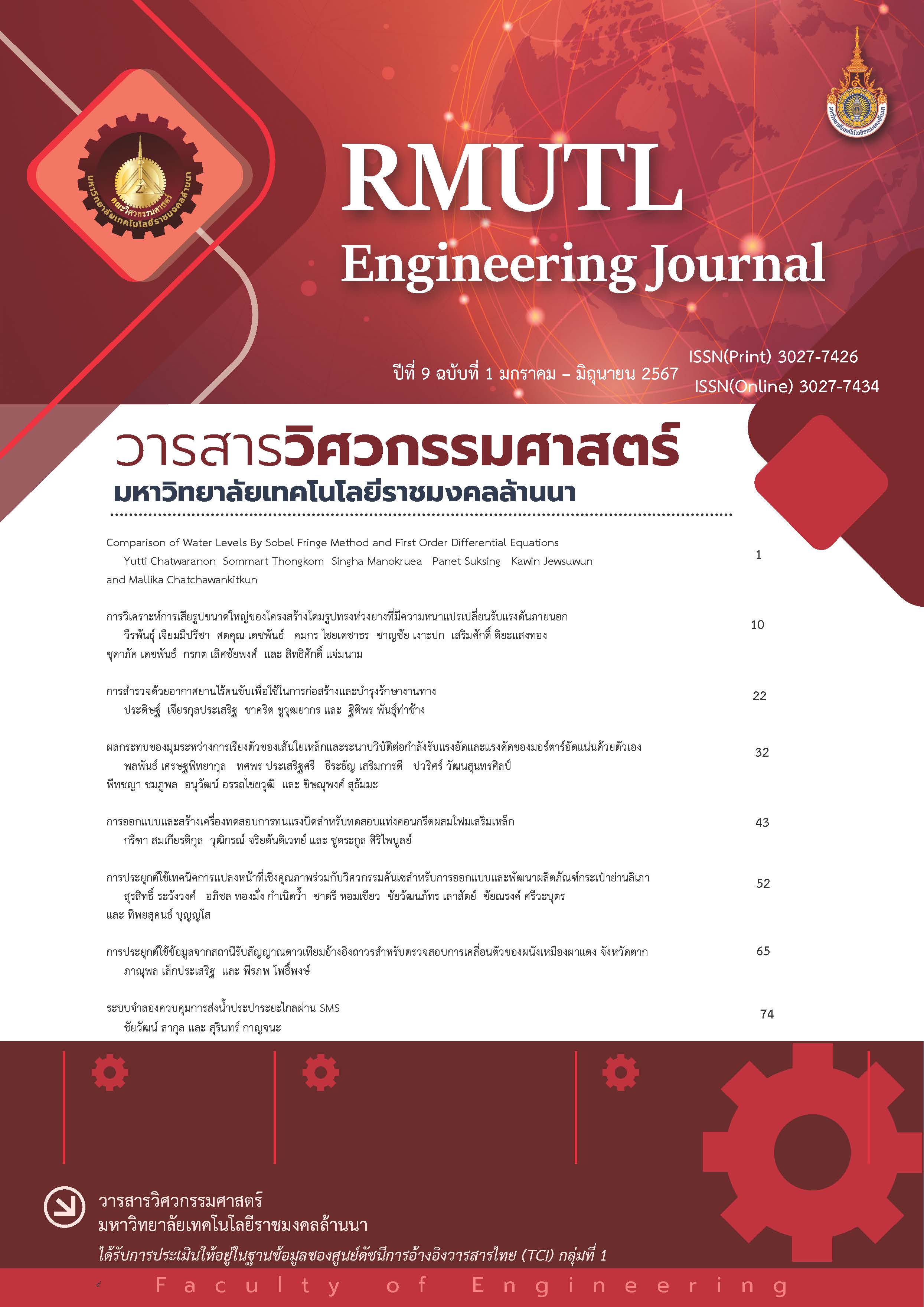Effect of the Angle between Steel Fiber Orientation and Failure Plane on Compressive and Flexural Strengths of Self-Compacting Mortars
DOI:
https://doi.org/10.14456/rmutlengj.2024.4Keywords:
Compressive strength, Fiber orientation, Flexural strength, Self-compacting mortar, Steel fibersAbstract
This paper presents effects of the angle between steel fiber orientation and failure plane (qf) on compressive strength and flexural strength of self-compacting mortar. Mortar proportions contained water to cement ratio of 35% and 45% with sand to mortar ratio of 40%, 45% and 50%. Fiber quantity of 0.8% and 1.6% by volume of mortar are compared and the influence of the angle between steel fiber orientation and failure plane (qf) of 0°, 30°, 45°, and 90° is studied. Research results showed that the compressive strength increased approximately 20% by increasing fiber amount of 0.8%, but it was found that the compressive strength reduced with the increase of steel fiber to 1.6%. The angle between steel fiber orientation and failure plane (qf) at 30° and 45°. affected in an increase in flexural strength by an average of 50%-70% when compared to the qf of 0°. However, it was found that the compressive strength decreased from the highest value by approximately 20%-30% with the qf of 90°. The most efficient reinforcing steel fiber in self-compacting mortar requires a consideration of fiber content, fiber orientation, and failure plane.
References
Larsen IL, Thorstensen RT. The influence of steel fibres on compressive and tensile strength of ultra high performance concrete: A Review. Construction and Building Materials. 2020 ; 30256:119459.
Wang X, Fan F, Lai J, Xie Y. Steel fiber reinforced concrete: A review of its material properties and usage in tunnel lining. InStructures 2021; 1 (34), 1080-1098.
Frazao C, Barros J, Bogas JA, Garcia-Cortes V, Valente T. Technical and environmental potentialities of recycled steel fiber reinforced concrete for structural applications. Journal of Building Engineering. 2022; 45:103579.
Qin X, Kaewunruen S. Environment-friendly recycled steel fibre reinforced concrete. Construction and Building Materials. 2022 ;327:126967.
Vairagade VS, Kene KS. Strength of normal concrete using metallic and synthetic fibers. Procedia Engineering. 2013;51:132-40.
Zheng Y, Wu X, He G, Shang Q, Xu J, Sun Y. Mechanical properties of steel fiber-reinforced concrete by vibratory mixing technology. Advances in Civil Engineering. 2018.
Sukontasukkul P, Chaisakulkiet U, Jamsawang P, Horpibulsuk S, Jaturapitakkul C, Chindaprasirt P. Case investigation on application of steel fibers in roller compacted concrete pavement in Thailand. Case Studies in Construction Materials. 2019; 11:e00271.
Trabucchi I, Tiberti G, Conforti A, Medeghini F, Plizzari GA. Experimental study on Steel Fiber Reinforced Concrete and Reinforced Concrete elements under concentrated loads. Construction and Building Materials. 2021 ;307:124834.
Jongvivatsakul P, Attachaiyawuth A, Pansuk W. A crack-shear slip model of high-strength steel fiber-reinforced concrete based on a push-off test. Construction and Building Materials. 2016 ;126:924-35.
Smittakorn W, Prasertsri T, Pattharakorn W, Jongvivatsakul P. Shear performance of special dry joints for precast concrete segments. ASEAN Engineering Journal. 2021;11:60-72.
Sukontasukkul P, Jamnam S, Sappakittipakorn M, Banthia N. Preliminary study on bullet resistance of double-layer concrete panel
made of rubberized and steel fiber reinforced concrete. Materials and Structures. 2014; 47(1-2):117-125.
Maho B, Sukontasukkul P, Jamnam S,Yamaguchi E, Fujikake K, Banthia N. Effect of rubber insertion on impact behavior of multilayer steel fiber reinforced concrete bulletproof panel. Construction and Building Materials. 2019; 216:476-84.
Okamura H, Ouchi M. Self-compacting concrete. Journal of Advanced Concrete Technology. 2003;1(1):5-15.
Ouchi M, Attachaiyawuth A. History and Development of High-Performance Concrete in Japan. J. of Thailand Concrete Association. 2015 ; 3(2):1-7.
Attachaiyawuth A, Rath S, Tanaka K, Ouchi M. Improvement of Self-Compactability of Air-Enhanced Self-Compacting Concrete with Fine Entrained Air. Journal of Advanced Concrete Technology. 2016;14(3):55-59. Available from: https://doi.org/10.3151/jact.14.55
Puthipad N, Ouchi M, Rath S, Attachaiyawuth A. Enhancement in self-compactability and stability in volume of entrained air in self-
compacting concrete with high volume fly ash. Construction and Building Materials. 2016 ;128:349-60.
Ouchi M, Kameshima K, Attachaiyawuth A. Improvement in self-compacting properties of fresh concrete by eliminating large air bubbles using an antifoaming agent. Journal of Advanced Concrete Technology. 2017; 15(1):10-8.
Puthipad N, Ouchi M, Rath S, Attachaiyawuth A. Enhanced entrainment of fine air bubbles in self-compacting concrete with high volume of fly ash using defoaming agent for improved entrained air stability and higher aggregate content. Construction and Building Materials. 2017; 144:1-2.
Rath S, Ouchi M, Puthipad N, Attachaiyawuth A. Improving the stability of entrained air in self-compacting concrete by optimizing the mix viscosity and air entraining agent dosage. Construction and Building Materials. 2017 ;148:531-7.
Rath S, Puthipad N, Attachaiyawuth A, Ouchi M. Critical size of entrained air to stability of air volume in mortar of self-compacting concrete at fresh stage. Journal of Advanced Concrete Technology. 2017; 15(1):29-37.
Puthipad N, Ouchi M, Attachaiyawuth A. Effects of fly ash, mixing procedure and type of air-entraining agent on coalescence of entrained air bubbles in mortar of self-compacting concrete at fresh state. Construction and Building Materials. 2018; 180:437-44.
Falmata AM, Sulaiman A, Mohamed RN, Shettima AU. Mechanical properties of self-compacting high-performance concrete with fly
ash and silica fume. SN Applied Sciences. 2020; 2:1-1.
Yanweerasak T, Kittikornjarus B, Pakwat P, Plongpan T, Attachaiyawuth A. Flowability, Viscosity and Internal Friction of Self-
Compacting Mortar as Affected by Its Mix Proportions. KMUTT Research & Development Journal. 2021; 44(3):409-426. Thai.
Attachaiyawuth A, Puthipad N, Ouchi M. Effects of air-entraining agent, defoaming agent and mixing time on characteristic of entrained bubbles in air-enhanced self-compacting concrete mixed at concrete plant. Engineering Journal. 2022; 26(2):37-48.
Mahmod M, Hanoon AN, Abed HJ. Flexural behavior of self-compacting concrete beams strengthened with steel fiber reinforcement. Journal of Building Engineering. 2018; 16:228-37.
Devi GS, Prasad CV, Rao PS. Influence of mineral admixtures on structural behaviour of Quaternary Blended Self Compacting Concrete reinforced beams with addition of crimpled steel fibers. Materials Today: Proceedings. 2022 ;57:2325-9.
aldeen Odaa S, Hason MM, Sharba AA. Self-compacting concrete beams reinforced with steel fiber under flexural loads: A ductility index evaluation. Materials Today: Proceedings. 2021 ; 42:2259-67.
Li N, Lu Y, Li S, Gao D. Axial compressive behaviour of steel fibre reinforced self-stressing and self-compacting concrete-filled steel tube columns. Engineering Structures. 2020 ;222:111108.
Zamri NF, Mohamed RN, Awalluddin D, Abdullah R. Experimental evaluation on punching shear resistance of steel fibre
reinforced self-compacting concrete flat slabs. Journal of Building Engineering. 2022 ;15.52:104441.
Ramkumar KB, Rajkumar PK, Ahmmad SN, Jegan M. A review on performance of self-compacting concrete–use of mineral admixtures and steel fibres with artificial neural network application. Construction and Building Materials. 2020 ;261:120215.
Sanjeev J, Nitesh KS. Study on the effect of steel and glass fibers on fresh and hardened properties of vibrated concrete and self-
compacting concrete. Materials Today: Proceedings. 2020; 27:1559-68.
Kotwal S, Singh H, Kumar R. Experimental investigation of Steel Fibre reinforced Self Compacting Concrete (SCC) using recycled aggregates as partial replacement of coarse aggregates. Materials Today: Proceedings. 2022 ;48:1032-7.
Thailand Industrial Standard. Tis no. 15-1 Specifications for Portland Cement Type 1. 2012 Thai.
Astm C. 150, Standard specification for Portland cement. Annual book of ASTM standards. 2002;4:134-8.
ASTM A. A123/A123M-17, Standard Specification for Zinc (Hot-Dip Galvanized) Coatings on Iron and Steel Products.
bosfa.com [Internet]. Products dramix-5d-4d-3d [cited 2023 Feb 27]. Available from: https://bosfa.com/wpcontent/uploads/2017/
/3D_6535BG.pdf
Downloads
Published
How to Cite
Issue
Section
License

This work is licensed under a Creative Commons Attribution-NonCommercial-NoDerivatives 4.0 International License.










